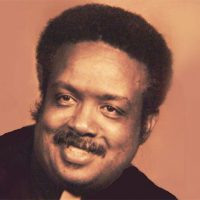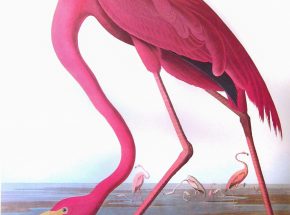

Ellis Buckner’s life is less well known than many of the other Highwaymen, mostly because he died very young. In 2004 his son, Ellis Buckner, Jr., set out to change his Dad’s lack of visibility when he wrote the book, “Florida Landscape Through the Eyes of the Buckner Brothers.” From Ellis, Jr., we learn that his father was a highly religious and devoted family man, as well as being a talented painter and a skilled entrepreneur.
Born in the African American section of Vero Beach called Gifford, Ellis was born the second oldest of twelve children. One of his brothers drowned at a young age. The family was close-knit, and religious education was highly valued. Ellis’ mother, Gladys, was a good cook and he often helped her in the kitchen. Like his brother George, who was a year older, Ellis dropped out of school to help support his family after his father died. His formal education, therefore, was limited to the ninth grade. Even before that time, his school attendance was sporadic. When Ellis and George played hooky from school, their father wouldn’t have them idling away their day. He took them to the groves to pick fruit. He figured if they weren’t getting an education, they could still help support the family.
Ellis’ father embedded a strong work ethic in him. He honed his business skills at an early age, peddling vegetables from his garden at his own produce stand. If he went fishing and had had a good catch, he sold a few fish. He had a knack for figuring things out. It is said that he could take a car motor apart and put it back together again in good working condition. He made signs for businesses and was employed as a car detailer for a short time. He worked the orange groves during the harvesting season and partnered with George in cutting lawns and running a barbecue business. With his astute business sense, Ellis was a good provider for his family. He was constantly thinking about how to make a few extra dollars.
When he was young, Ellis’ brother George bought him a painting set for $10 and he painted his first picture, a seascape, in his family’s backyard. His mother sold it for $25 to a lady whose house she cleaned. Years later, as Ellis was improving as an artist, he was troubled about the poor quality of that painting. Feeling badly about the sale, he brought the lady one of his more accomplished paintings.
Ellis and George were introduced to the idea of painting professionally by Harold Newton, who they saw painting one day in Gifford. Harold told the brothers that he, Alfred Hair, and others were making good money selling their artwork. Livingston Roberts was also making money selling landscape paintings. He lived nearby in a rental, over Club Bally in Gifford, and often came to their barbecue shop to purchase sandwiches.
Ellis and George were intrigued with the work that Harold and Livingston were doing, so they stopped picking oranges and learned to paint. Ellis figured that if he could earn even a portion of what Harold was making, he’d be doing well. He told a reporter, “Fifty dollars could buy seven bags of groceries.” Not only was the money attractive, the flexible lifestyle that came with being one’s own boss was highly appealing. Harold gave the Buckner brothers some quick painting lessons and they began to visit Livingston who offered a few tips. Then they began experimenting. They continued to watch Harold and Livingston paint and went to visit Bean Backus in his studio to learn all they could.
Ellis married Betty Smith from Panama City. Together they had two children, son Ellis Jr., and a daughter. In October 1973, after being married for only a short time, Betty and her daughter were killed in a car crash. Ellis was devastated, but happy to have his son Ellis, Jr. alive and well. Healing from his grief took time. Family members and neighbors pitched in to help raise his young son. He later met and married Bettye Fuller from Pompano. Together they had two children, Ellise and Elliot.
Ellis sometimes painted with his brother, George. They also painted separately in their home studios. Their different personalities suited their partnership. George was more of a loner, preferring to stay home and paint. Ellis, more outgoing and with good organizational skills, was the salesman. At one time, they had a gallery in Miami. Ellis and his family lived upstairs; Bettye handled sales on the lower level where the paintings were displayed. George painted in his Gifford home and brought his paintings to the Miami gallery to sell. Sometimes Ellis met him halfway to collect his work. When the gallery closed, the family returned to Gifford.
In keeping with the way he was raised, Ellis had a strong belief in God. He was an active member of a Gifford Pentecostal church, where his brother Jack was the minister and he had the role of elder minister. George played the keyboard and Ellis sang and played the baritone during services. He spent long hours working as an evangelist. When he got sick with diabetes, he believed that God’s grace would heal him.
In 1991 at age fifty-eight, George died of complications related to diabetes. He did not live long enough to see the revival of interest in the Highwaymen. But as a strong believer in God’s will, he understood that when he was called from this earth, it was time to go. Ellis Buckner, Jr., continues his father’s legacy as a painter.
His Painting
Ellis and George started their painting careers using oil-based house paint because it was cheaper than purchasing artist paint. But the results weren’t good. When they switched to inexpensive oil paint, they still weren’t happy. They finally figured they had to purchase quality supplies.
Together the brothers studied books on perspective, vanishing points and horizon lines. They discussed how to create depth in their landscapes. In their early work, they used a triangle square to assist them with creating perspective. They practiced ways of making shadows and enhancing sunlight. Their paintings were never completed as quickly as Alfred Hair and other Fort Pierce painters. The Buckner brothers were more calculated as they worked.
Much of Ellis’ work has a sense of stillness to it and his color palette is more realistic than many of the other Highwaymen works. He liked placing birds in his landscapes and carefully depicted reflections in the water. George may have been the better painter, but a quality landscape by Ellis Buckner can easily move the spirit in appreciation of nature’s beauty.
https://thehighwaymentrail.com/ellis-buckner/
Website
https://thehighwaymentrail.com/
